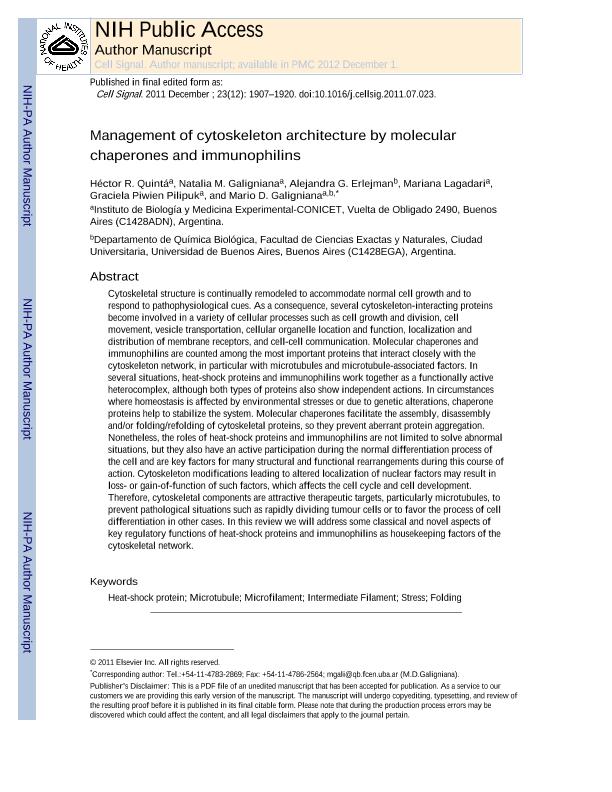Mostrar el registro sencillo del ítem
dc.contributor.author
Quintá, Héctor Ramiro

dc.contributor.author
Galigniana, Natalia Maricel

dc.contributor.author
Erlejman, Alejandra Giselle

dc.contributor.author
Lagadari, Mariana

dc.contributor.author
Piwien Pilipuk, Graciela

dc.contributor.author
Galigniana, Mario Daniel

dc.date.available
2017-03-20T18:46:57Z
dc.date.issued
2011-12
dc.identifier.citation
Quintá, Héctor Ramiro; Galigniana, Natalia Maricel; Erlejman, Alejandra Giselle; Lagadari, Mariana; Piwien Pilipuk, Graciela; et al.; Management of cytoskeleton architecture by molecular chaperones and immunophilins; Elsevier Science Inc; Cellular Signalling; 23; 12; 12-2011; 1907-1920
dc.identifier.issn
0898-6568
dc.identifier.uri
http://hdl.handle.net/11336/14110
dc.description.abstract
Cytoskeletal structure is continually remodeled to accommodate normal cell growth and to respond to pathophysiological cues. As a consequence, several cytoskeleton-interacting proteins become involved in a variety of cellular processes such as cell growth and division, cell movement, vesicle transportation, cellular organelle location and function, localization and distribution of membrane receptors, and cell-cell communication. Molecular chaperones and immunophilins are counted among the most important proteins that interact closely with the cytoskeleton network, in particular with microtubules and microtubule-associated factors. In several situations, heat-shock proteins and immunophilins work together as a functionally active heterocomplex, although both types of proteins also show independent actions. In circumstances where homeostasis is affected by environmental stresses or due to genetic alterations, chaperone proteins help to stabilize the system. Molecular chaperones facilitate the assembly, disassembly and/or folding/refolding of cytoskeletal proteins, so they prevent aberrant protein aggregation. Nonetheless, the roles of heat-shock proteins and immunophilins are not only limited to solve abnormal situations, but they also have an active participation during the normal differentiation process of the cell and are key factors for many structural and functional rearrangements during this course of action. Cytoskeleton modifications leading to altered localization of nuclear factors may result in loss- or gain-of-function of such factors, which affects the cell cycle and cell development. Therefore, cytoskeletal components are attractive therapeutic targets, particularly microtubules, to prevent pathological situations such as rapidly dividing tumor cells or to favor the process of cell differentiation in other cases. In this review we will address some classical and novel aspects of key regulatory functions of heat-shock proteins and immunophilins as housekeeping factors of the cytoskeletal network.
dc.format
application/pdf
dc.language.iso
eng
dc.publisher
Elsevier Science Inc

dc.rights
info:eu-repo/semantics/openAccess
dc.rights.uri
https://creativecommons.org/licenses/by-nc-nd/2.5/ar/
dc.subject
Chaperones
dc.subject
Cytoskeleton
dc.subject
Immunophilins
dc.subject
Hsp90
dc.subject.classification
Bioquímica y Biología Molecular

dc.subject.classification
Ciencias Biológicas

dc.subject.classification
CIENCIAS NATURALES Y EXACTAS

dc.title
Management of cytoskeleton architecture by molecular chaperones and immunophilins
dc.type
info:eu-repo/semantics/article
dc.type
info:ar-repo/semantics/artículo
dc.type
info:eu-repo/semantics/publishedVersion
dc.date.updated
2017-03-08T15:18:35Z
dc.identifier.eissn
1873-3913
dc.journal.volume
23
dc.journal.number
12
dc.journal.pagination
1907-1920
dc.journal.pais
Reino Unido

dc.journal.ciudad
Oxford
dc.description.fil
Fil: Quintá, Héctor Ramiro. Consejo Nacional de Investigaciones Científicas y Técnicas. Instituto de Biología y Medicina Experimental (i); Argentina
dc.description.fil
Fil: Galigniana, Natalia Maricel. Consejo Nacional de Investigaciones Científicas y Técnicas. Instituto de Biología y Medicina Experimental (i); Argentina
dc.description.fil
Fil: Erlejman, Alejandra Giselle. Universidad de Buenos Aires. Facultad de Ciencias Exactas y Naturales. Departamento de Química Biológica; Argentina
dc.description.fil
Fil: Lagadari, Mariana. Consejo Nacional de Investigaciones Científicas y Técnicas. Instituto de Biología y Medicina Experimental (i); Argentina
dc.description.fil
Fil: Piwien Pilipuk, Graciela. Consejo Nacional de Investigaciones Científicas y Técnicas. Instituto de Biología y Medicina Experimental (i); Argentina
dc.description.fil
Fil: Galigniana, Mario Daniel. Consejo Nacional de Investigaciones Científicas y Técnicas. Instituto de Biología y Medicina Experimental (i); Argentina. Universidad de Buenos Aires. Facultad de Ciencias Exactas y Naturales. Departamento de Química Biológica; Argentina
dc.journal.title
Cellular Signalling

dc.relation.alternativeid
info:eu-repo/semantics/altIdentifier/url/http://www.sciencedirect.com/science/article/pii/S0898656811002476
dc.relation.alternativeid
info:eu-repo/semantics/altIdentifier/doi/http://dx.doi.org/10.1016/j.cellsig.2011.07.023
dc.relation.alternativeid
info:eu-repo/semantics/altIdentifier/url/https://www.ncbi.nlm.nih.gov/pmc/articles/PMC3184352/
Archivos asociados
